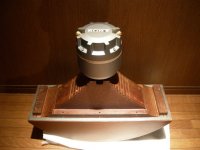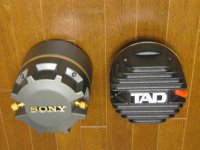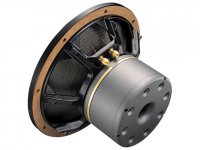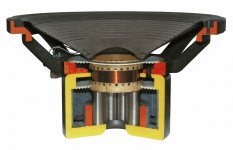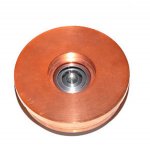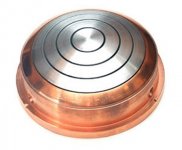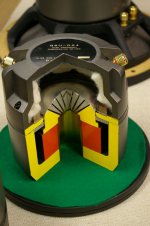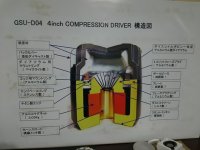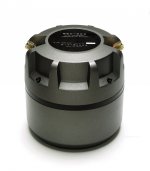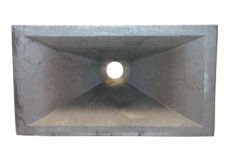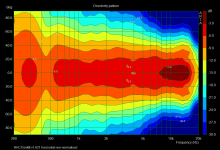So you're saying nobody can make this driver again? It sounds like hyperbole to me + reading about people can smoke without smelling it in the building, pffht!
Nice story though!
No, that's not what I am saying
In fact, there's a very small company that made (or still makes) the SUP-T11.
Sony never produced any of their PA drivers and horns in house, instead they bought custom products from third party manufacturers, like McCauley.
Attachments
The Sony SUP T-11 for comparison:
Attachments
-
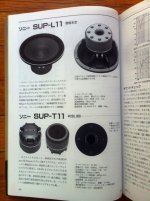 SUP.jpg803 KB · Views: 150
SUP.jpg803 KB · Views: 150 -
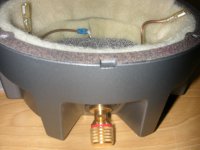 img_81159_159203_0.jpg345.1 KB · Views: 119
img_81159_159203_0.jpg345.1 KB · Views: 119 -
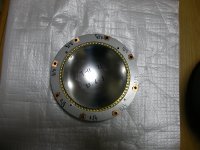 img_81159_159153_0.jpg367.2 KB · Views: 120
img_81159_159153_0.jpg367.2 KB · Views: 120 -
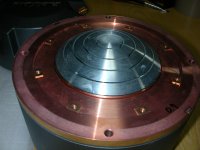 img_81159_159122_0.jpg334.9 KB · Views: 124
img_81159_159122_0.jpg334.9 KB · Views: 124 -
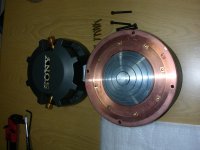 img_1 (4).jpg379.1 KB · Views: 137
img_1 (4).jpg379.1 KB · Views: 137 -
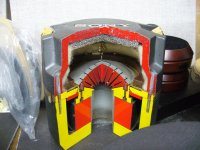 img_0 (9).jpg203.2 KB · Views: 143
img_0 (9).jpg203.2 KB · Views: 143 -
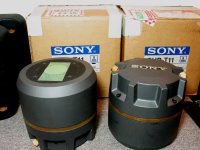 d0056197_8493887.jpg228.5 KB · Views: 138
d0056197_8493887.jpg228.5 KB · Views: 138 -
 9C01-6.jpg107.4 KB · Views: 141
9C01-6.jpg107.4 KB · Views: 141
These guys should be able to help you out.
Specs:
DRIVER GSU-D04
It reproduces flatly up to 24kHz by super-light diaphragm. A tweeter and a super tweeter are unnecessary.
Thickness 35μm aluminum diaphragm and the voice coil is electric welded.(no glue) →Light weight vibration system. It is almost flat up to 24kHz. Even a minute signal reproduces plainly.
Adopted pure brass throat with gold plating → The throat has huge effect on sound quality. By making it in pure brass it is able to create a clear sound.
Adopt strong alnico magnet (weight: 3.1Kg) →High magnetic induction of 20,000 gauss.
Phase plug is assembled without any glue. All machined out structure →Low distortion and improvement in low frequency and magnetic efficiency.
Adopt edge wise wind up voice coil →superior in conductivity and line mount pure aluminum stute wire for excellent reliability and linear.
Adopt aluminum machined out phase plug →By its multiplex structure it produces solid structure and beautiful finish with low distortion.
Back cover is made from zinc which has high vibration absorption character →Lowers Back Chamber's resonance and natural sound with no coloration.
Precise parts, production quality control, measurement and adjustment →All products are matched→Left and right channels sound uniforms→Low distortion.
Official impedance: 12.5Ω
[Horn throat] diameter: 49.2mm
Voice coil diameter: 101mm
Bandwidth: 500-24,000Hz
Recommended crossover frequency: More than 500Hz
Ratings input: 25W
Output sound pressure level: 110dB/W/m
Magnetic induction: 20,000 Gausses
Externals size (outside diameter × height): 178×175mm
Mass: 18kg
Specs:
DRIVER GSU-D04
It reproduces flatly up to 24kHz by super-light diaphragm. A tweeter and a super tweeter are unnecessary.
Thickness 35μm aluminum diaphragm and the voice coil is electric welded.(no glue) →Light weight vibration system. It is almost flat up to 24kHz. Even a minute signal reproduces plainly.
Adopted pure brass throat with gold plating → The throat has huge effect on sound quality. By making it in pure brass it is able to create a clear sound.
Adopt strong alnico magnet (weight: 3.1Kg) →High magnetic induction of 20,000 gauss.
Phase plug is assembled without any glue. All machined out structure →Low distortion and improvement in low frequency and magnetic efficiency.
Adopt edge wise wind up voice coil →superior in conductivity and line mount pure aluminum stute wire for excellent reliability and linear.
Adopt aluminum machined out phase plug →By its multiplex structure it produces solid structure and beautiful finish with low distortion.
Back cover is made from zinc which has high vibration absorption character →Lowers Back Chamber's resonance and natural sound with no coloration.
Precise parts, production quality control, measurement and adjustment →All products are matched→Left and right channels sound uniforms→Low distortion.
Official impedance: 12.5Ω
[Horn throat] diameter: 49.2mm
Voice coil diameter: 101mm
Bandwidth: 500-24,000Hz
Recommended crossover frequency: More than 500Hz
Ratings input: 25W
Output sound pressure level: 110dB/W/m
Magnetic induction: 20,000 Gausses
Externals size (outside diameter × height): 178×175mm
Mass: 18kg
They also make some of the horns that were used in Sony SEM and PA loudspeakers, as well as a few other designs.
Attachments
-
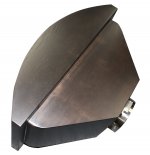 woodhorn-0910-01.jpg275.4 KB · Views: 60
woodhorn-0910-01.jpg275.4 KB · Views: 60 -
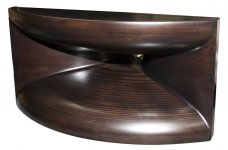 woodhorn-0910-03.jpg234.5 KB · Views: 56
woodhorn-0910-03.jpg234.5 KB · Views: 56 -
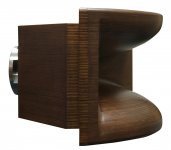 gt_horn01_301-03.jpg219.7 KB · Views: 52
gt_horn01_301-03.jpg219.7 KB · Views: 52 -
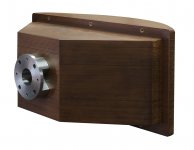 gt_horn01_301-04.jpg207.5 KB · Views: 48
gt_horn01_301-04.jpg207.5 KB · Views: 48 -
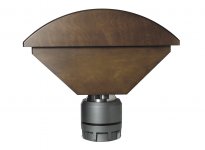 gh301a-16541211.jpg187.6 KB · Views: 58
gh301a-16541211.jpg187.6 KB · Views: 58 -
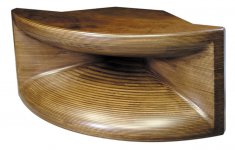 gh301g.jpg245.5 KB · Views: 67
gh301g.jpg245.5 KB · Views: 67 -
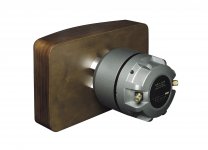 gh502a-17721280.jpg208.7 KB · Views: 61
gh502a-17721280.jpg208.7 KB · Views: 61 -
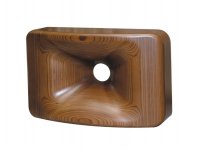 gh502-14171050.jpg152.4 KB · Views: 61
gh502-14171050.jpg152.4 KB · Views: 61 -
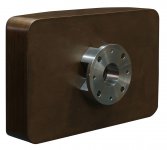 gt_horn01_502-05.jpg227.4 KB · Views: 64
gt_horn01_502-05.jpg227.4 KB · Views: 64 -
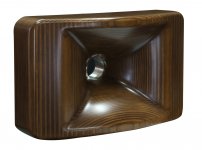 gt_horn01_502-04.jpg243 KB · Views: 105
gt_horn01_502-04.jpg243 KB · Views: 105
Last edited:
Are those GSU-D04 currently available? Price?
1. yes.
2. ..boutique production from Japan, if you have to ask you probably can't afford it.
GT SOUND?FAQ
GT SOUND DRIVER GSU-D04
In 2006 the GSU-D04 cost about 504.000 Yen, which is about € 4214, or $ 4648 today.
So, far more expensive than even the TAD TD4002.
Here's some additional background info on the driver (horrible translation):
"As for the connection between SONY and GT Sound, I thought that “GT Sound” was the manufacturer of SONY unit until I visited, but the representative Mr. Goto was originally an audio player from an audio shop. ・ "SUP-T11G", the successor to Sony's "SUP-T11", is a driver that he made a specially designed for Sony with a 35mm thin diaphragm for consumer use. Even after SONY stopped unit sales The improvement of the phase plug, the back chaffin, and the material of the slot were improved to become GT Sound “GSU-D04”, and the content of the improvement was rational in acoustic engineering, such as eliminating resonance thoroughly. However, the thoroughness is similar to the company's woofer “GSU-W16” although there are structural differences.
About the difference between SONY (SUP-T11) and GT Sound “GSU-D04”
1. Change the material of the phase plug from resin to metal (copper)
2. Change the phase plug to 4 slits, and from the vibration version The lengths of the compression paths were evenly aligned.
3. Changed the driver's horn slot from resin to stainless steel.
4. Changed the back cabinet material from magnesium alloy to aluminum alloy.
5. Change the shape of the edge of the vibration plate
About the difference between SONY (SUP-L11) and GT Sound “GSU-W16”
1. Change the voice coil's bobbin from aluminum to paper
2. Change the voice coil from aluminum to copper
3. Change the material of the center cap of the magnet.
4. Unevenly change the thickness of the rib to prevent the split vibration of the cone paper.
I think the main changes that memorize the shape of the center cap are as above, but at the production stage It was said that the characteristics were measured in an anechoic chamber one by one, with an emphasis on aligning the characteristics by minimizing the error of the noise.
In any case, it seems that the real background is that the audio mania was so high that the specifications that had been ordered by SONY were commercialized, and the withdrawal of SONY put it in the position of direct production of speaker systems. It is.
I have built an original specification speaker system with the Advanced4350A concept with the aim of becoming a speaker that exceeds that, with my main focus on audio as the main speaker, but the final demand is It is common.
However, there is a sense of music, sympathy for product ownership and brand, sympathy for the media, insight into audio equipment and acoustic engineering, economic power, housing environment, family understanding, and interaction with people who love audio. It is interesting that there are differences in various approaches and ways of enjoying (some people suffer) depending on differences.
In the process of pursuing the ultimate audio reproduction art, Mr. Goto of “GT Sound” has kept his uncompromising attitude, and the speaker system developed by investing private property has been raised to a great degree of perfection, and it is just praised. Deserve.
It is a speaker system that visitors of this blog should listen to with their own sensibilities, but if it is not an audio file that has undergone trial and error in the creation of the sound of the speaker as such, it may not be possible to understand the true awesomeness I think.
In terms of product value, the performance is quite cheap, but since it is not a mass-produced product, the audio files that can be purchased in terms of cost will be limited, but there will continue to be excellent products in GT Sound. I hope the section will continue and hope to find another opportunity to visit."
So, far more expensive than even the TAD TD4002.
Here's some additional background info on the driver (horrible translation):
"As for the connection between SONY and GT Sound, I thought that “GT Sound” was the manufacturer of SONY unit until I visited, but the representative Mr. Goto was originally an audio player from an audio shop. ・ "SUP-T11G", the successor to Sony's "SUP-T11", is a driver that he made a specially designed for Sony with a 35mm thin diaphragm for consumer use. Even after SONY stopped unit sales The improvement of the phase plug, the back chaffin, and the material of the slot were improved to become GT Sound “GSU-D04”, and the content of the improvement was rational in acoustic engineering, such as eliminating resonance thoroughly. However, the thoroughness is similar to the company's woofer “GSU-W16” although there are structural differences.
About the difference between SONY (SUP-T11) and GT Sound “GSU-D04”
1. Change the material of the phase plug from resin to metal (copper)
2. Change the phase plug to 4 slits, and from the vibration version The lengths of the compression paths were evenly aligned.
3. Changed the driver's horn slot from resin to stainless steel.
4. Changed the back cabinet material from magnesium alloy to aluminum alloy.
5. Change the shape of the edge of the vibration plate
About the difference between SONY (SUP-L11) and GT Sound “GSU-W16”
1. Change the voice coil's bobbin from aluminum to paper
2. Change the voice coil from aluminum to copper
3. Change the material of the center cap of the magnet.
4. Unevenly change the thickness of the rib to prevent the split vibration of the cone paper.
I think the main changes that memorize the shape of the center cap are as above, but at the production stage It was said that the characteristics were measured in an anechoic chamber one by one, with an emphasis on aligning the characteristics by minimizing the error of the noise.
In any case, it seems that the real background is that the audio mania was so high that the specifications that had been ordered by SONY were commercialized, and the withdrawal of SONY put it in the position of direct production of speaker systems. It is.
I have built an original specification speaker system with the Advanced4350A concept with the aim of becoming a speaker that exceeds that, with my main focus on audio as the main speaker, but the final demand is It is common.
However, there is a sense of music, sympathy for product ownership and brand, sympathy for the media, insight into audio equipment and acoustic engineering, economic power, housing environment, family understanding, and interaction with people who love audio. It is interesting that there are differences in various approaches and ways of enjoying (some people suffer) depending on differences.
In the process of pursuing the ultimate audio reproduction art, Mr. Goto of “GT Sound” has kept his uncompromising attitude, and the speaker system developed by investing private property has been raised to a great degree of perfection, and it is just praised. Deserve.
It is a speaker system that visitors of this blog should listen to with their own sensibilities, but if it is not an audio file that has undergone trial and error in the creation of the sound of the speaker as such, it may not be possible to understand the true awesomeness I think.
In terms of product value, the performance is quite cheap, but since it is not a mass-produced product, the audio files that can be purchased in terms of cost will be limited, but there will continue to be excellent products in GT Sound. I hope the section will continue and hope to find another opportunity to visit."
Last edited:
Diffraction is intrisic to every horn and waveguide. The amounts vary, but in my experience as well as that of others, the perceived net effect on the acoustic performance and listening experience of a properly designed complete loudspeaker system may be insignificant.
A bar of 30ppi foam, placed in the slot, further reduces typical diffraction artefacts.
I cannot disagree with you more strongly. I have done research into the perception of diffraction and I can assure you that our conclusions do not support your opinion.
Horn diffraction can range from highly diffracted to almost none. That's why horns sound so different. Diffraction, IMO, is the single most important factor to sound quality. Almost to the exclusion of all else.
Hi Earl
But wouldn't the directivity control of a 15" woofer be as bad at 400 Hz ?
Regards
Charles
Show me where a single 15” woofers dispersion varies widely from the next as far as the standard looking woofer....not gonna happen unless a waveguide or enclosure is factored in. Generally speaking 15” woofer and a horn with the same circumference is going loose directivity at the wavelength matching its size. I’m interested in the “horn loading” not being a real factor....what’s that supposed to mean
Last edited:
I cannot disagree with you more strongly. I have done research into the perception of diffraction and I can assure you that our conclusions do not support your opinion.
Horn diffraction can range from highly diffracted to almost none. That's why horns sound so different. Diffraction, IMO, is the single most important factor to sound quality. Almost to the exclusion of all else.
Of this I am fully aware. At the same time it's highly unlikely many top rated studios, as well as the Max Planck Institute would spend a considerable amount of money on monitor loudspeakers with a 'horrendous diffraction horn', unless it wouldn't adversely affect sound quality.
Last edited:
Of this I am fully aware. At the same time it's highly unlikely many top rated studios, as well as the Max Planck Institute would spend a considerable amount of money on monitor loudspeakers with an 'inferior horn'.
Don't bet on that.
A guy, who also cooperated with mabat on the STH/ATH project, reworked the throat section of a 2" Aluminum horn - similar to the ZXPC 10x18.
Driver used is an older 2" B&C.
Driver used is an older 2" B&C.
Attachments
I’m interested in the “horn loading” not being a real factor....what’s that supposed to mean
Horn loading is a key feature of 'classical horns' (Salmon family). Your own horns belong to this category as well.
As regards modern waveguide type of horns, the loading aspect is largely ignored in favor of directivity characteristics.
G.T. Sound prices
In 2013 the GSU-D04 compression driver cost 780,000 Yen (or 5515.00 euros).
Prices for 2010 of other G.T. Sound products:
Loudspeaker systems (prices are for a pair, I think):
SRS-1A (maple wood version) 6,163,500yen (approx 49308euro)
SRV-1A (maple wood version) 8,505,000yen (approx 68040euro)
SRH-1A (maple wood version) 8,421,000yen (approx 67368euro )
SFS-2A 4,767,000yen (approx 38136eur)
Woofers - pair of GSU-W16 1,008,000yen (approx 8064euro)
Compression drivers - pair of GSU-WD04 1,428,000yen (approx 11424euro)
Ultra High - pair of GSU-UH1 1,470,000yen (approx 11760euro)
Horns - pair of GH-301A (made of laminated maple wood) 1,386,000yen (approx 11088euro)
Horns - pair of GH-301B (made of laminated birch wood) 1,008,000yen (approx 8064euro)
Horns - pair of GH-501A (made of laminated maple wood) 588,000yen (approx 4704euro)
Horns - pair of GH-501B (made of laminated birch wood) 462,000yen (approx 3696euro)
Crossovers - pair of Network for single woofer 630,000yen (approx 5040euro)
Crossovers - pair of Network for double woofer 1,115,000yen (approx 9240euro).
In 2013 the GSU-D04 compression driver cost 780,000 Yen (or 5515.00 euros).
Prices for 2010 of other G.T. Sound products:
Loudspeaker systems (prices are for a pair, I think):
SRS-1A (maple wood version) 6,163,500yen (approx 49308euro)
SRV-1A (maple wood version) 8,505,000yen (approx 68040euro)
SRH-1A (maple wood version) 8,421,000yen (approx 67368euro )
SFS-2A 4,767,000yen (approx 38136eur)
Woofers - pair of GSU-W16 1,008,000yen (approx 8064euro)
Compression drivers - pair of GSU-WD04 1,428,000yen (approx 11424euro)
Ultra High - pair of GSU-UH1 1,470,000yen (approx 11760euro)
Horns - pair of GH-301A (made of laminated maple wood) 1,386,000yen (approx 11088euro)
Horns - pair of GH-301B (made of laminated birch wood) 1,008,000yen (approx 8064euro)
Horns - pair of GH-501A (made of laminated maple wood) 588,000yen (approx 4704euro)
Horns - pair of GH-501B (made of laminated birch wood) 462,000yen (approx 3696euro)
Crossovers - pair of Network for single woofer 630,000yen (approx 5040euro)
Crossovers - pair of Network for double woofer 1,115,000yen (approx 9240euro).
Ro808 qoute: Diffraction is intrisic to every horn and waveguide
Reply
This has got me very curious as I really want to like horns - Can someone suggest a HF horn with driver that is "almost diffraction free", ready to be intigrated with a LF driver?
Reply
I cannot disagree with you more strongly. I have done research into the perception of diffraction and I can assure you that our conclusions do not support your opinion.
Horn diffraction can range from highly diffracted to almost none. That's why horns sound so different. Diffraction, IMO, is the single most important factor to sound quality. Almost to the exclusion of all else.
This has got me very curious as I really want to like horns - Can someone suggest a HF horn with driver that is "almost diffraction free", ready to be intigrated with a LF driver?
- Home
- Loudspeakers
- Multi-Way
- Is it possible to cover the whole spectrum, high SPL, low distortion with a 2-way?
